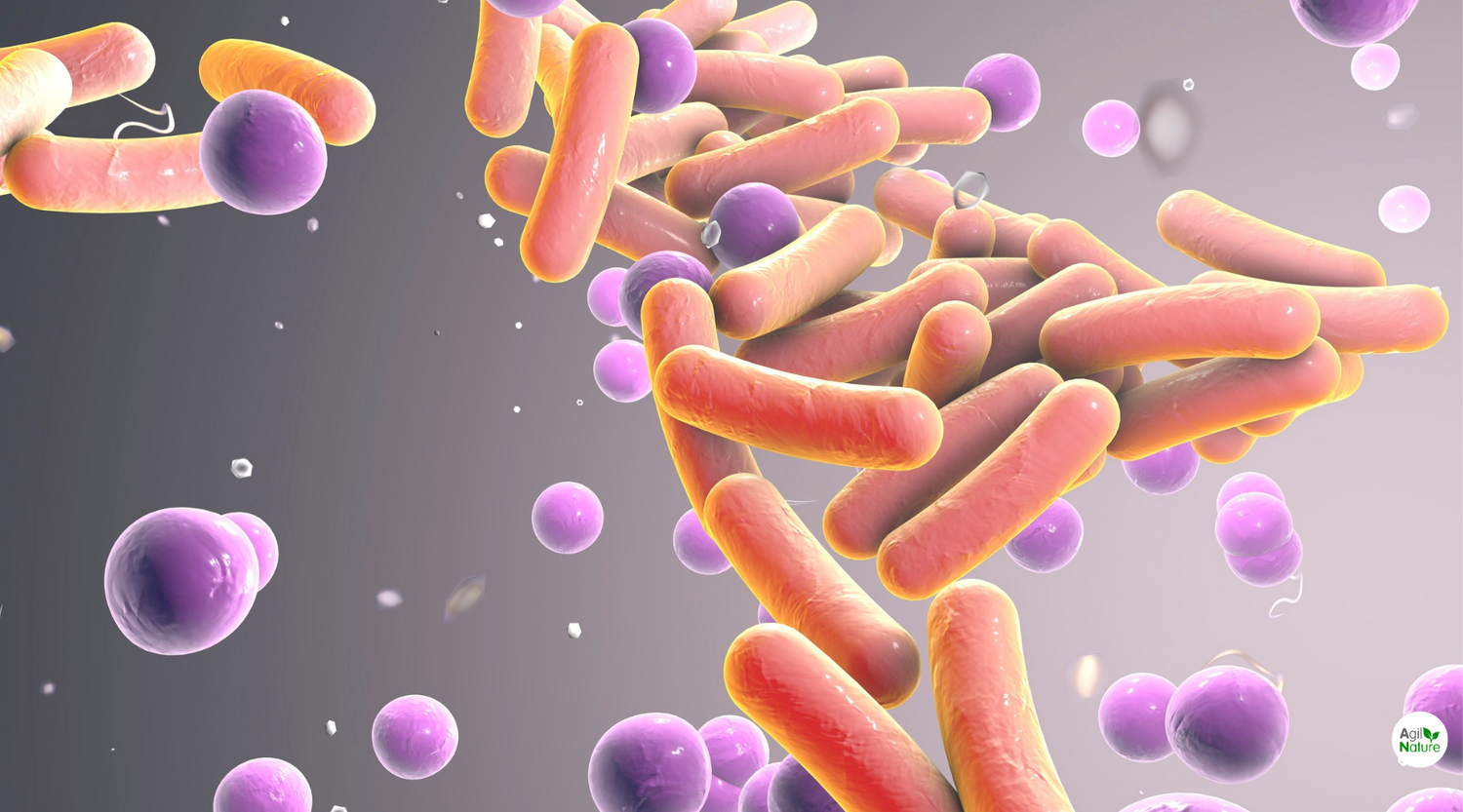
Lactobacillus rhamnosus
Überblick:
Lactobacillus rhamnosus, früher als Unterart von Lactobacillus casei betrachtet, ist ein gram-positives Milchsäurebakterium der Familie Lactobacillaceae. Als Milchsäurebakterium fermentiert es Glukose, den einfachen Zucker, zu Milchsäure, die auch als Lebensmittelzusatzstoff E 270 verwendet wird. Da Milch nur im Namen enthalten ist, jedoch nichts mit Laktose zu tun hat, haben Laktoseintolerante Menschen dabei nichts zu befürchten. Seit der Entdeckung des Bakteriums ist es das am besten untersuchte probiotische Bakterium der Welt mit einer großen Menge an Studien.
Lactobacillus rhamnosus findet seinen Haupteinsatz als Probiotikum. Als Probiotika bezeichnet man lebende Mikroorganismen, die in gewissen Mengen, Vorteile für die Gesundheit bieten beispielsweise durch Einfluss auf das Darmmikrobiom. Erwähnenswert ist, dass die derzeitige wissenschaftliche Ansicht ist, dass Lactobacillus rhamnosus nur ein vorübergehender Bewohner in unserem Darm ist und nach Einnahme als Probiotikum nicht dauerhaft im Darm bleibt, sobald man die Einnahme absetzt.
Zahlreiche vorteilhafte Wirkungen des Bakteriums die bisher entdeckt wurden sind und als Probiotikum interessant sind:
-
Fördert Darmgesundheit: L. rhamnosus reparierte in Studien eine schon geschädigte Schutzbarriere im Dickdarm und regte auch die Produktion von Mucin, einem Baustein dieser, an. In Mäusen zeigte sich somit eine Verbesserung von Darmstörungen wie beispielsweise Verstopfungen. Zusätzlich reguliert es die Darmflora, indem es die die Vermehrung der nützlichen Bakterien fördert und das Wachstum von schädlichen Bakterien hemmt.
-
Immunsystem-Regulation: L. rhamnosus wirkte in Studien stimulierend auf die natürliche Immunabwehr und sorgte für ein Gleichgewicht. Dank der fördernden Wirkung zeigte es in Studien an Hamstern & Mäusen positiven Einfluss auf Krankheiten wie Entzündungsreaktionen bei rheumatischer Arthritis, Osteoporose und chronischen Entzündungen des Dickdarms (colitis)
-
Atemwegserkrankungen: Aufgrund von Studien wird vermutet, dass L. rhamnsosus eine leichte prophylaktische Rolle bei der Prävention und Behandlung von einigen Atemwegserkrankungen einnehmen könnte. Da Untergewicht bei Kindern mit einem hohen Risiko für verschiedene Infektionen einhergeht, wurde L. rhamnosus in diesem Kontext untersucht. Auch hier senkte L. rhamnosus das Infektionsrisiko und die daraus hergehende Atemwegserkrankungen.
-
Blutdrucksenkung: In Kombination mit Bifidobacterium lactis reduzierte die Einnahme der Probiotika nach 16 Wochen Einnahme in einer Studie den Blutdruck durch Veränderung der Komposition der Darmflora. In Kombination mit den richtigen Probiotika könnte L. rhamnosus daher eine positive Auswirkung haben auf den Blutdruck bei längerer Einnahme.
-
Hilfe bei Durchfall: Mehrere Studien, sowohl mit Kindern als auch mit Erwachsenen, weisen auf eine Verbesserung der Durchfalldauer und der Symptome bei verschiedenen Ursachen hin. Durch Rotaviren erkrankte Kinder hatten durch L. rhamnosus ein geringeres Risiko, länger als eine Woche an Durchfallsymptomen zu leiden. Durchfall ist vor allem bei der Behandlung mit Antibiotika ein großes Problem, aber das Risiko wurde bei Erwachsenen durch L. rhamnosus als Probiotikum verringert. Die Wissenschaft geht daher davon aus, dass die Häufigkeit, Dauer und Schwere von Durchfallerkrankungen durch L. rhamnosus verringert werden kann. Die Europäische Behörde für Lebensmittelsicherheit bestätigt dies nach Testung im Jahr 2013 jedoch nicht, daher ist dies nicht als klare Aussage möglich, sondern gilt als Vermutung zu zählen.
Weitere Studien
Weitere gesundheitliche Vorteile, die in Studien gefunden wurden und vermutet werden:
-
Positiver Einfluss auf die Darm-Hirn-Achse: Neuerdings bekannt nimmt die Gesundheit des Darms Einfluss auf das Hirn, den beide beeinflussen einander durch die Darm-Hirn-Achse. In Mäusen nahm L. rhamnosus positiven Einfluss auf diese, indem dadurch lärminduzierte kognitive Defizite gelindert wurden und da bei Einnahme im jungen Alter, die Nachfahren ein geringeres ängstliches Verhalten aufwiesen.
-
Insulinresistenz: In einer Studie an Mäusen schaffte L. rhamnsosus, den Blutzucker zu regulieren durch Senkung der Insulinresistenz. Zusätzlich zeigte sich auch eine geringere Gewichtszunahme im Vergleich zu den Kontrollmäusen.
-
Lactoseintoleranz: Eine Studie zeigte, dass L. rhamnosus zusammen mit Bifidobacterium longum und Vitamin B6, Symptome, die bei einer Lactoseintoleranz auftreten linderten. So hatten die Probanden dank dieser Probiotika weniger Verstopfungen und Blähungen.
-
Leberschützend: Zusammen mit Inosin verbesserte L. rhamnosus in Mäusen alkoholinduzierte Leberschäden.
-
Atherosklerose: Durch Einfluss auf den Fettsäure- und Ketonkörperstoffwechsel, verlangsamte in einer Tierstudie L. rhamnosus das Fortschreiten von Atherosklerose.
Empfohlene Dosierungen und Anwendungshinweise
Die optimale Dosierung von Lactobacillus rhamnosus kann variieren, basierend auf dem individuellen Gesundheitszustand und dem gewünschten Effekt. Allgemein liegen die Dosierungen in Nahrungsergänzungsmitteln zwischen 1 und 2 Milliarden koloniebildenden Einheiten (KBE) pro Tag. Für spezifische Anwendungen, wie die Behandlung von Reizdarmsyndrom, können höhere Dosierungen angemessen sein.
Ernährungsempfehlungen zur Unterstützung der Wirkung
Eine ballaststoffreiche Ernährung unterstützt die Wirkung von Probiotika meistens, da Präbiotika wie Ballaststoffe das Wachstum und die Aktivität von probiotischen Bakterien im Darm fördern. Lebensmittel wie Vollkornprodukte, Gemüse und Obst sind empfehlenswert. Zudem sollte auf eine ausreichende Flüssigkeitsaufnahme geachtet werden.
Wir von AgilNature haben uns in unserem “SynbioticAgil” Produkt, dass dich mit Probiotika wie Lactobacillus rhamnosus versorgt, auch um Präbiotika gekümmert um die beste Wirkung zu entfalten. So enthält unser Produkt SynbioticAgil zusätzlich das Präbiotikum Inulin.
Gefahren bei Einnahme
Die Einnahme von Lactobacillus rhamnosus Stämmen, de vermarktet werden als Probiotika, gelten als sicher in Bezug auf die Gesundheit. Seltener kann es jedoch zu Sepsis führen, bei bestimmten Risikogruppen. Menschen mit schwachem Immunsystem und Babys zählen zur Risikogruppe und sollten daher auf Einnahme verzichten.
Welche AgilNature® Produkte enthalten Lactobacillus rhamnosus?
|
Produkt |
Menge |
NRV* |
|
SynbioticAgil |
6 x 109 KBE pro Tagesration (6 Kapseln) |
** |
*Nutrient Reference Value = Prozentsatz des Referenzwertes nach Anlage XIII der Lebensmittelinformationsverordnung VO (EG) Nr. 1169/2011.
** Keine Empfehlung vorhanden.
*** KBE = Kolonie bildende Einheiten
Literatur:
-
G. W. Tannock, K. Munro u. a.: Analysis of the fecal microflora of human subjects consuming a probiotic product containing Lactobacillus rhamnosus DR20. In: Applied and environmental microbiology. Band 66, Nummer 6, Juni 2000, S. 2578–2588, ISSN 0099-2240.
-
Blaabjerg S, Artzi DM, Aabenhus R. Probiotics for the Prevention of Antibiotic-Associated Diarrhea in Outpatients—A Systematic Review and Meta-Analysis. Antibiotics. 2017; 6(4):21.
-
Zhang Y, Zheng T, Ma D, Shi P, Zhang H, Li J, Sun Z.2023.Probiotics Bifidobacterium lactis M8 and Lactobacillus rhamnosus M9 prevent high blood pressure via modulating the gut microbiota composition and host metabolic products. mSystems8:e00331-23.
-
Guandalini, Stefano; Pensabene, Licia; Zikri, Mona Abu*; Dias, Jorge Amil†; Casali, Luigi Gobio‡; Hoekstra, Hans§; Kolacek, Sanja÷; Massar, Karin§; Micetic–Turk, Dusanka; Papadopoulou, Alexandra#; de Sousa, Jaime Salazar**; Sandhu, Bhupinder††; Szajewska, Hanna‡‡; Weizman, Zvi§§. Lactobacillus GG Administered in Oral Rehydration Solution to Children with Acute Diarrhea: A Multicenter European Trial. Journal of Pediatric Gastroenterology and Nutrition 30(1):p 54-60, January 2000.
-
Österlund, P., Ruotsalainen, T., Korpela, R. et al. Lactobacillus supplementation for diarrhoea related to chemotherapy of colorectal cancer: a randomised study. Br J Cancer 97, 1028–1034 (2007).
-
Vitellio P, Celano G, Bonfrate L, Gobbetti M, Portincasa P, De Angelis M. Effects of Bifidobacterium longum and Lactobacillus rhamnosus on Gut Microbiota in Patients with Lactose Intolerance and Persisting Functional Gastrointestinal Symptoms: A Randomised, Double-Blind, Cross-Over Study. Nutrients. 2019 Apr 19;11(4):886.
-
Arellano-García L, Macarulla MT, Cuevas-Sierra A, Martínez JA, Portillo MP, Milton-Laskibar I. Lactobacillus rhamnosus GG administration partially prevents diet-induced insulin resistance in rats: a comparison with its heat-inactivated parabiotic. Food Funct. 2023 Oct 2;14(19):8865-8875.
-
Sapra L, Saini C, Das S, Mishra PK, Singh A, Mridha AR, Yadav PK, Srivastava RK. Lactobacillus rhamnosus (LR) ameliorates pulmonary and extrapulmonary acute respiratory distress syndrome (ARDS) via targeting neutrophils. Clin Immunol. 2024 Jan;258:109872.
-
Kumpu, M., Kekkonen, R., Kautiainen, H. et al. Milk containing probiotic Lactobacillus rhamnosus GG and respiratory illness in children: a randomized, double-blind, placebo-controlled trial. Eur J Clin Nutr 66, 1020–1023 (2012).
-
Kara SS, Volkan B, Erten I. Lactobacillus rhamnosus GG can protect malnourished children. Benef Microbes. 2019 Apr 19;10(3):237-244.
-
Guo M, Liu H, Yu Y, Zhu X, Xie H, Wei C, Mei C, Shi Y, Zhou N, Qin K, Li W. Lactobacillus rhamnosus GG ameliorates osteoporosis in ovariectomized rats by regulating the Th17/Treg balance and gut microbiota structure. Gut Microbes. 2023 Jan-Dec;15(1):2190304.
-
Tripathy A, Swain N, Padhan P, Raghav SK, Gupta B. Lactobacillus rhamnosus reduces CD8+T cell mediated inflammation in patients with rheumatoid arthritis. Immunobiology. 2023 Jul;228(4):152415.
-
Tong L, Zhang X, Hao H, Liu Q, Zhou Z, Liang X, Liu T, Gong P, Zhang L, Zhai Z, Hao Y, Yi H. Lactobacillus rhamnosus GG Derived Extracellular Vesicles Modulate Gut Microbiota and Attenuate Inflammatory in DSS-Induced Colitis Mice. Nutrients. 2021 Sep 23;13(10):3319.
-
Gill HS, Rutherfurd KJ, Prasad J, Gopal PK. Enhancement of natural and acquired immunity by Lactobacillus rhamnosus (HN001), Lactobacillus acidophilus (HN017) and Bifidobacterium lactis (HN019). Br J Nutr. 2000 Feb;83(2):167-76.
-
Chen L, Li S, Peng C, Gui Q, Li J, Xu Z, Yang Y. Lactobacillus rhamnosus GG Promotes Recovery of the Colon Barrier in Septic Mice through Accelerating ISCs Regeneration. Nutrients. 2023 Jan 28;15(3):672.
-
Gu Y, Qin X, Zhou G, Wang C, Mu C, Liu X, Zhong W, Xu X, Wang B, Jiang K, Liu J, Cao H. Lactobacillus rhamnosus GG supernatant promotes intestinal mucin production through regulating 5-HT4R and gut microbiota. Food Funct. 2022 Nov 28;13(23):12144-12155.
-
Li X, Zheng P, Cao W, Cao Y, She X, Yang H, Ma K, Wu F, Gao X, Fu Y, Yin J, Wei F, Jiang S, Cui B. Lactobacillus rhamnosus GG ameliorates noise-induced cognitive deficits and systemic inflammation in rats by modulating the gut-brain axis. Front Cell Infect Microbiol. 2023 Apr 26;13:1067367.
-
Zhou B, Jin G, Pang X, Mo Q, Bao J, Liu T, Wu J, Xie R, Liu X, Liu J, Yang H, Xu X, Wang B, Cao H. Lactobacillus rhamnosus GG colonization in early life regulates gut-brain axis and relieves anxiety-like behavior in adulthood. Pharmacol Res. 2022 Mar;177:106090.
-
Zhai T, Ren W, Wang P, Zheng L. Lactobacillus rhamnosus GG protects against atherosclerosis by improving ketone body synthesis. Appl Microbiol Biotechnol. 2022 Dec;106(24):8233-8243.
-
Zhu Y, Wang X, Zhu L, Tu Y, Chen W, Gong L, Pan T, Lin H, Lin J, Sun H, Ge Y, Wei L, Guo Y, Lu C, Chen Y, Xu L. Lactobacillus rhamnosus GG combined with inosine ameliorates alcohol-induced liver injury through regulation of intestinal barrier and Treg/Th1 cells. Toxicol Appl Pharmacol. 2022 Mar 15;439:115923.
-
Cukrowska B, Ceregra A, Maciorkowska E, Surowska B, Zegadło-Mylik MA, Konopka E, Trojanowska I, Zakrzewska M, Bierła JB, Zakrzewski M, Kanarek E, Motyl I. The Effectiveness of Probiotic Lactobacillus rhamnosus and Lactobacillus casei Strains in Children with Atopic Dermatitis and Cow's Milk Protein Allergy: A Multicenter, Randomized, Double Blind, Placebo Controlled Study. Nutrients. 2021 Apr 1;13(4):1169.
-
Boggio Marzet C, Burgos F, Del Compare M, Gerold I, Tabacco O, Vinderola G. Approach to probiotics in pediatrics: the role of Lactobacillus rhamnosus GG. Arch Argent Pediatr. 2022 Feb;120(1):e1-e7. English, Spanish.
-
Chiang MC, Chen CL, Feng Y, Chen CC, Lien R, Chiu CH. Lactobacillus rhamnosus sepsis associated with probiotic therapy in an extremely preterm infant: Pathogenesis and a review for clinicians. J Microbiol Immunol Infect. 2021 Aug;54(4):575-580.
-
Zhang B, Lynch B, Zhao J, Guo Y, Mak A. Lactobacillus rhamnosus MP108: Toxicological evaluation. J Food Sci. 2021 Jan;86(1):228-241.

